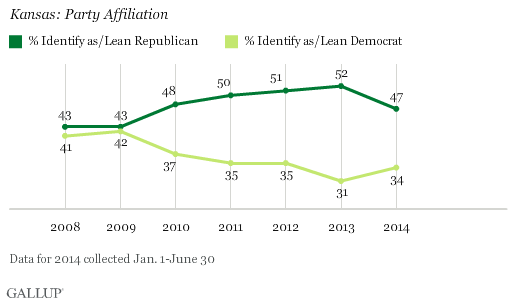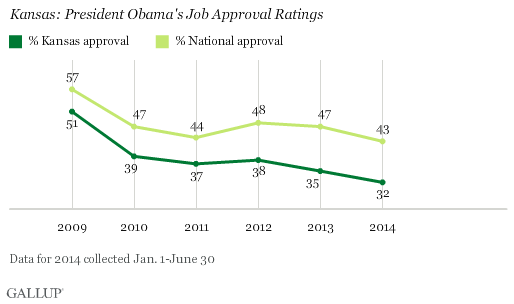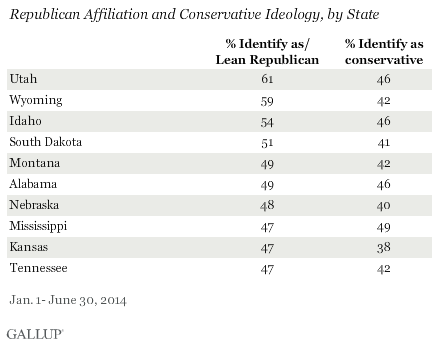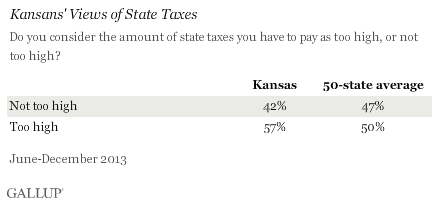WASHINGTON, D.C. -- Kansas has emerged as an unlikely battleground state in the 2014 midterm election, with two longtime Republican fixtures, U.S. Sen. Pat Roberts and Gov. Sam Brownback, facing competitive races. These races threaten to sweep the GOP out of two of the state's most prominent positions. Adding to the element of surprise is the fact that residents of the Sunflower State still strongly favor the GOP in terms of party identification, although the Republican edge dropped in the first half of this year to its lowest point since 2009.

In the first six months of 2014, nearly half of Kansans (47%) said they leaned toward or identified with the GOP -- down five percentage points from 2013, but still giving Republicans a wide margin over Democrats in party affiliation.
The GOP is unquestionably the dominant political party within the state of Kansas, holding both Senate and all four House seats and controlling supermajorities in the state legislature. Any Republican nominee for president can consider Kansas a sure bet -- the state last voted for a Democrat, Lyndon Johnson, in 1964.
Kansas' Republican leanings have generally intensified throughout Barack Obama's presidency, as Gallup's Daily tracking data evince, though the first half of 2014 saw a slight retreat in Republican support. Republicans have held a near or actual majority in party affiliation since the first year of Obama's presidency.
Undoubtedly, Kansas' low ratings of Obama's job performance have helped drive this trend. In the first half of 2014, just 32% of Kansans approved of Obama's performance -- 11 points below the national average. Kansas' approval of Obama is among the lowest in the nation.

 |
|
Discover how Americans rate their state in 2014, across key metrics |
These data generally suggest Republicans should be in a strong position for the midterm election, despite this year's drop in GOP identification. But statewide polling shows that both Roberts and Brownback have a real race on their hands. Roberts, who is battling for his fourth term in the Senate, finds himself in an unenviable position -- after once clearly leading a three-way race, he now trails independent candidate Greg Orman after Democrat Chad Taylor dropped out.
Kansas Least Conservative of Top 10 Republican States
Nearly as many Kansans describe their ideology as moderate (36%) as they do conservative (38%), which may be one reason the self-described moderate Orman is performing so well in the polls. The percentage of Kansas moderates is on par with the national figure, but higher than in other conservative-leaning states with key Senate elections this year, including North Carolina and Arkansas. And despite the conservative flavor of many Kansas politicians -- its delegation to the U.S. House was named by National Journal in 2012 as the most conservative of all delegations -- the state is not as conservative as other ruby-red states. Of the 10 states with the highest proportion of the population identifying with or leaning toward the GOP, Kansas has the lowest share of the population describing their political views as conservative. In other words, there is reason to believe a candidate stressing a moderate platform could be successful.

Additionally, one-fifth of Kansans (20%) describe themselves as liberal, meaning a solid majority (56%) describe themselves as either moderate or liberal.
Ideology, party identification, and several other political and economic measures for Kansas are included in Gallup's new State Scorecard assessments, which present data for 14 key measures for each of the 50 states. Within each assessment, the state's performance on the measure is compared with the national average for the same time period.
Despite Brownback's Tax-Cutting Agenda, Few Say Taxes Not Too High
Sam Brownback, a former U.S. representative and senator, was elected governor of Kansas in 2010 after pledging to reduce taxes -- and over the course of his term, he has delivered on that pledge. The governor, along with the GOP-led state legislature, cut personal income tax rates and made various other changes to the tax code to reduce liabilities. Despite the fact that many of these changes went into effect at the start of 2013, only 42% of Kansans said in a 2013 poll that state taxes are not too high, below the 50-state average of 47%.

Brownback promoted the tax-cutting legislation as actions that would create jobs and grow the state economy. However, Kansans had a relatively small amount of confidence in their state economy by the end of 2013. The state's Economic Confidence Index averaged +15, below the 50-state average of +23. And Kansans' views of the local job market were no more positive than those in most other states. For both questions, Kansas performed worse than three of the four states that border it -- Nebraska, Colorado, and Oklahoma. Only Missouri performed worse.
About Three in 10 Say Kansas Is Best State to Live in
One issue dogging Sen. Roberts stems from reports earlier this year that he does not have his own house in Kansas, leaving him open to one of the most deadly attacks in the political playbook -- that he is out of touch with his state. Yet it seems a sizable percentage of Kansans wouldn't mind having a home located elsewhere in the country either: Almost four in 10 Kansans (37%) say that if they had the opportunity, they would move to another state. About six in 10 (63%) say they would like to remain in Kansas. And just 34% of Kansans say their state is the best state to live in, well below the 50-state average of 46%.
Bottom Line
Kansas is not a state that usually comes up in discussions of battleground states -- the state last voted for a Democrat for president in 1964, and the last Democratic senator won his term in 1932. And given the national environment that appears to favor Republicans this fall, Kansas would seem an unlikely candidate for tight midterm races that could throw out two well-known Republican officials. For all the suspense, though, the GOP's strengths in this state could very well carry its candidates come November -- Republicans have a huge lead in self-reported political identification, and Obama registers one of his lowest job approval ratings in the country.
Yet, a GOP victory is not a foregone conclusion, and this must be quite a shock to the typically triumphant Kansas Republican Party. The political drama in Kansas is, if nothing else, a reminder that ideology and job performance matter, even in states with well-rooted political identities.
Survey Methods
Results for this Gallup poll are based on telephone interviews conducted Jan. 1-June 30, 2014, on the Gallup Daily tracking survey, with a random sample of 88,802 adults, aged 18 and older, living in all 50 U.S. states and the District of Columbia. Results are also based on Gallup's recent 50-state poll conducted June-December 2013 with a random sample of approximately 600 adults per state, aged 18 and older, living in all 50 U.S. states.
For results based on the 2014 sample of 866 Kansas residents, the margin of sampling error is ±4 percentage points at the 95% confidence level.
For results based on the 2013 sample of adults per state, the margin of sampling error is ±5 percentage points at the 95% confidence level.
For both the Gallup Daily tracking poll and the 50-state poll, interviews are conducted with respondents on landline telephones and cellular phones, with interviews conducted in Spanish for respondents who are primarily Spanish-speaking. Landline telephone numbers and cellphone numbers are selected using random-digit-dial methods. Landline respondents are chosen at random within each household on the basis of which member had the most recent birthday. In the Gallup Daily tracking poll, each sample of national adults includes a minimum quota of 50% cellphone respondents and 50% landline respondents, with additional minimum quotas by region. In the 50-state poll, each sample of national adults includes minimum quotas of cellphone respondents and landline respondents based on cellphone and landline use in the respective state. Samples are weighted to correct for unequal selection probability, nonresponse, and double coverage of landline and cell users in the two sampling frames. They are also weighted to match demographics of gender, age, race, Hispanic ethnicity, education, region, population density, and phone status (cellphone only/landline only/both, cellphone mostly, and having an unlisted landline number). Demographic weighting targets are based on the most recent Current Population Survey figures for the aged 18 and older U.S. population. Phone status targets are based on the most recent National Health Interview Survey. Population density targets are based on the most recent U.S. census. All reported margins of sampling error include the computed design effects for weighting.
In addition to sampling error, question wording and practical difficulties in conducting surveys can introduce error or bias into the findings of public opinion polls.
For more details on Gallup's polling methodology, visit www.gallup.com.
